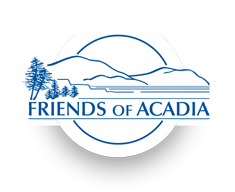From the Mount Desert Islander, July 15, 2016
By Anne Kozak
BAR HARBOR — While the needs Friends of Acadia (FOA) addressed in its first 25 years involved successful and compelling initiatives – the Island Explorer, Carriage Road Restoration project and Acadia Trials Forever – the challenges now are less tangible and more societal, said FOA president David MacDonald. Today FOA, Acadia National Park and its partners must address challenges involving climate change, transportation, youth and the quality of the visitor experience.
After a century of development and recreation, Acadia’s natural and cultural resources have degraded. To combat this degradation and to ensure that the resources are resilient enough to bounce back after severe storms, pollution, pests and a steady increase in visitors, the park, FOA and other partners have developed a program to restore the ecological integrity, natural resilience and historical authenticity of watersheds in Acadia.
Over time, the initiative Wild Acadia will examine some priority watersheds – Marshall Brook, Northeast Creek, Otter Creek and Stanley Brook. But the initial effort is focusing on the Cromwell Brook watershed, a watershed that includes Dorr Mountain and the Tarn and flows through Sieur de Mont and the Great Meadow into Cromwell Cove.
This watershed not only has historic fish runs, a large wetland, old forest stands and wildlife but also includes Sieur de Mont Spring, an important cultural landscape. Even before the area achieved national monument status, it was a focal point. Many paths led from the village to the area; George Dorr and the Village Improvement Association had constructed numerous trails up and around Dorr and Champlain Mountains. The area also includes the Abbe Museum, Wild Gardens of Acadia and the Nature Center which is opening new exhibits focusing on the effects of climate change on Acadia’s cultural and natural resources.
Rebecca Cole-Will, chief of resources at Acadia, said that many of the challenges in the watershed are interrelated and stem from past development. To address flooding from increasingly strong rain events, the park and FOA have replaced major culverts, built an elevated boardwalk on the Jesup Path to improve water flow and opened stream barriers to restore fish passageways. The park replanted the pool area at Sieur de Mont Spring with native plants.
“This is a groundbreaking program to stay ahead of the effects of climate change, and it’s a concerted effort for which FOA is providing matching funds,” said MacDonald. “Another aspect of our efforts is not only making the public more aware of climate change but also ensuring that natural communities stay as healthy as possible so they can withstand the stresses of climate change.”
One way of keeping the public informed and of teaching young people about the effects of climate change and other resource issues is the Teacher-Ranger-Teacher program, a program funded by FOA. While many national parks host a teacher, Acadia hosted seven in 2014 and seven in 2015, said MacDonald.
“Youth engagement is a priority,” said MacDonald, “and FOA will continue to fund these programs as well as other youth initiatives.”
Congress and the park are the primary players in protecting and investing in resources, said MacDonald, and the park will be more successful in attracting public funds if Congress sees that the entrance fee program is successful and if the park is attracting private funds, such as those from FOA and other partners. “The partners give Acadia the liberty to be creative in protecting resources and developing programs,” said MacDonald.
At 30, FOA’s membership continues to grow, there are now 4,543 members. Since its founding in 1999, over six million people have ridden the Island Explorer, and in 2015 3,523 FOA volunteers contributed 45,623 hours to the park.
“Friends of Acadia sets the bar for philanthropic partners. It is phenomenal in targeting the highest needs of Acadia—the carriage roads and trails are in better condition because of FOA. The strength of Acadia’s partnership with FOA is one of the factors that attracted me to Acadia,” said superintendent Kevin Schneider.
Read the original: http://www.mdislander.com/acadia-centennial-2/acadias-friends-steadfast-30-years »
Reprinted with permission.
 Join
Join Donate
Donate Acadia National Park
Acadia National Park


